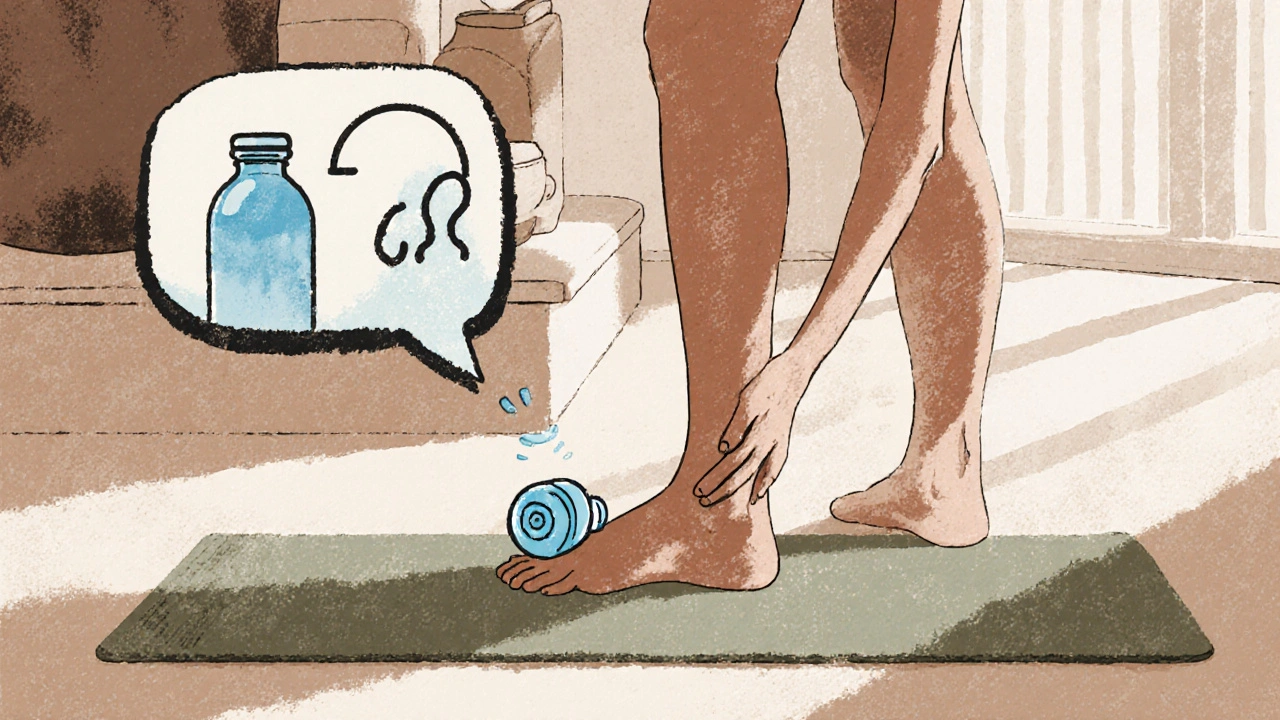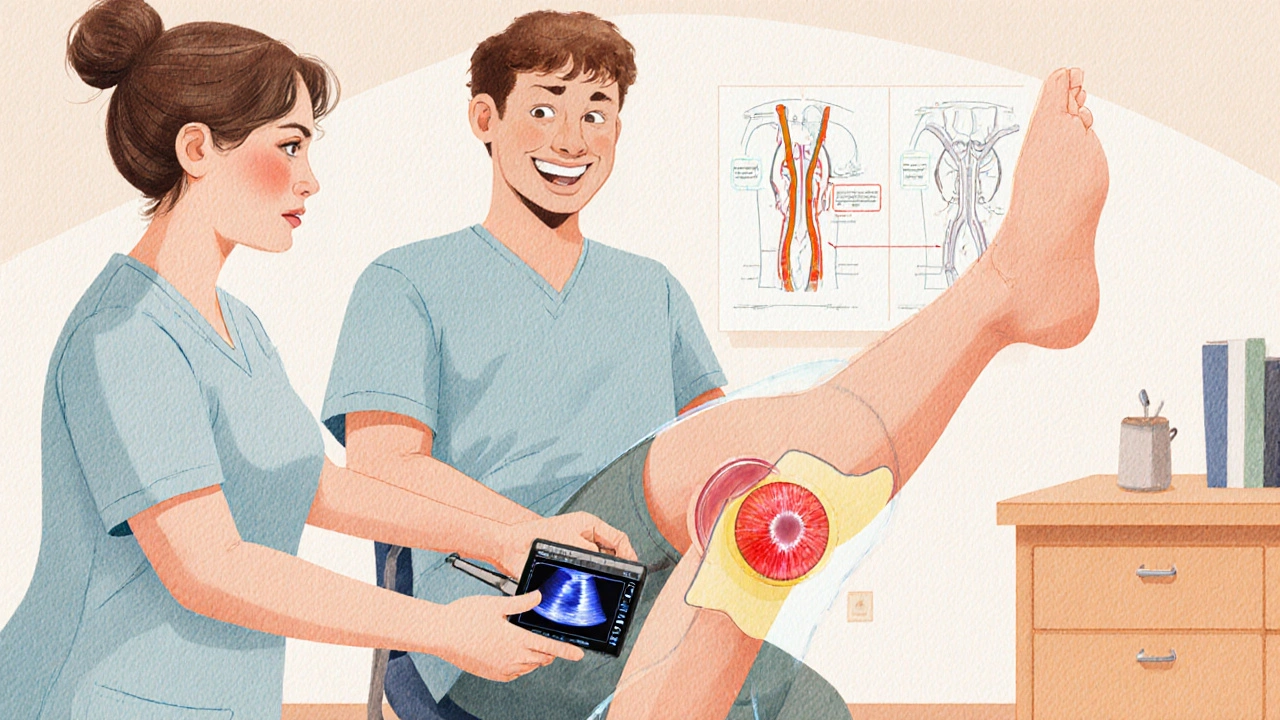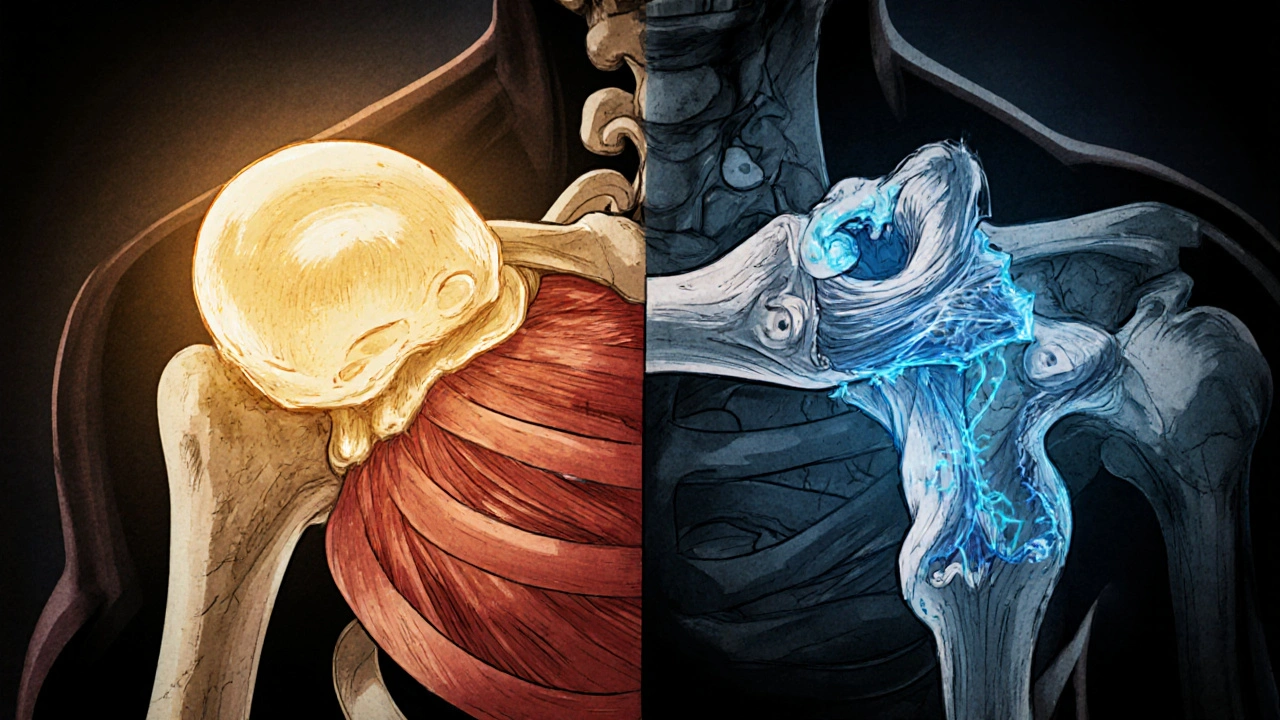What’s the Difference Between Bursitis and Tendinitis?
You’ve got pain around your shoulder, knee, or elbow. Maybe it hurts when you lift your arm, kneel down, or even sleep on that side. You’ve heard the terms bursitis and tendinitis thrown around, but what’s the real difference? And why does it matter?
Bursitis is inflammation of a bursa - a small, fluid-filled sac that acts like a cushion between bones, tendons, and muscles near your joints. Think of it as a shock absorber. When it gets irritated from too much pressure or friction, it swells up and causes pain. Common spots? The shoulder (subacromial), elbow (olecranon), hip (trochanteric), and knee (prepatellar).
Tendinitis, on the other hand, is inflammation of a tendon - the thick, rope-like tissue that connects muscle to bone. When you move, your tendon pulls on the bone. If that motion is repeated too often, or if the tendon is overworked, it gets inflamed. The most common areas are the rotator cuff in the shoulder, the Achilles tendon in the ankle, and the patellar tendon just below the kneecap.
Here’s the key: bursitis hurts when you press on the area or lie on it. Tendinitis hurts when you move the muscle that pulls on the tendon. That’s not just semantics - it changes how you treat it.
Why Misdiagnosis Makes Things Worse
Almost two-thirds of shoulder pain cases involve both bursitis and tendinitis happening at the same time. That’s why so many people get stuck in a cycle of wrong treatment.
Let’s say you have shoulder pain and assume it’s a "rotator cuff tear" because you read about it online. You start doing strengthening exercises - the kind you see on YouTube. But if what’s really going on is inflamed bursa, those exercises are rubbing the bursa against bone. Instead of healing, it gets worse.
Or worse - you get a cortisone shot. For bursitis? It often works great. For tendinitis? It might give you a few weeks of relief, but studies show it doesn’t fix the root problem. And if you get too many shots in a tendon, you risk weakening it enough to cause a tear.
According to the Journal of Orthopaedic & Sports Physical Therapy, people who get the wrong diagnosis take over three times longer to recover. That’s not just frustrating - it’s expensive. Lost workdays, repeated visits, unnecessary imaging - it adds up fast.
How Doctors Actually Diagnose These Conditions
Most doctors don’t start with an MRI. They start with your story and a physical exam.
For bursitis, they’ll press on the swollen area - the subacromial bursa near the top of your shoulder, or the bursa behind your knee. If that’s tender, and pain gets worse when you lie on it, that’s a strong clue.
For tendinitis, they’ll ask you to move your joint against resistance. Try lifting your arm sideways with a light weight. If it hurts along the path of the rotator cuff tendon, that’s tendinitis. Try bending your knee while keeping your foot flat - if the pain is sharp right below the kneecap, it’s likely patellar tendinitis.
Ultrasound is now the go-to imaging tool. It’s quick, cheap, and accurate - spotting inflammation in bursae and tendons with 92% sensitivity. MRI is overkill unless the pain doesn’t improve after weeks of rest or if there’s suspicion of a tear.
And here’s something most people don’t know: 40% of people over 50 show signs of bursitis or tendinitis on an MRI - even if they have zero pain. That’s why doctors are moving away from scanning first. Symptoms matter more than images.

What Actually Works: Treatment That Gets Results
Most cases don’t need surgery. In fact, fewer than 5% do. The fix starts with three things: rest, ice, and movement - but not the kind you think.
Step 1: Stop the Aggravating Motion
Don’t just "take a break." Be specific. If your shoulder hurts when you reach overhead, stop lifting boxes, painting ceilings, or doing push-ups. If your knee hurts when you kneel, get a cushion or switch to sitting on a stool. The goal isn’t total inactivity - it’s removing the trigger.
Step 2: Ice Like a Pro
Ice isn’t just for sprains. For both bursitis and tendinitis, cold reduces swelling and numbs pain. But don’t just slap an ice pack on it. Use a frozen water bottle. Roll it slowly over the sore spot for 10 minutes, 3 times a day. People who do this consistently report 73% better outcomes, according to MyHealthTeams user surveys.
Step 3: Move - But Correctly
This is where most people fail. You can’t just stretch. You need to rebuild strength in the right way.
For tendinitis, eccentric exercises are gold standard. For Achilles tendinitis, that means standing on your toes on a step, then slowly lowering your heel down - one leg at a time. Do 3 sets of 15, twice a day. It’s boring. It’s hard. But it works. The Alfredson protocol - 180 reps a day for 12 weeks - has been proven in clinical trials to outperform cortisone shots.
For bursitis, gentle movement helps prevent stiffness. Pendulum swings for the shoulder, or slow knee bends without weight, keep things moving without adding pressure.
Step 4: Medications - Use Them Wisely
NSAIDs like ibuprofen help with pain and swelling, but don’t take them for more than 10-14 days. They can irritate your stomach and kidneys. And never use them as a crutch to keep doing the activity that caused the problem.
Corticosteroid injections? They’re a tool, not a cure. For bursitis, they work well - 78% of patients report major improvement within four weeks. For tendinitis? Only 52%. And if you get more than two or three shots in a year, you risk tendon rupture. That’s why doctors now limit them.
What Doesn’t Work (And Why)
There’s a lot of noise out there. Let’s cut through it.
- Wearing a brace all day - It might feel supportive, but it weakens muscles. Use it only during aggravating activities, not constantly.
- Massaging the sore spot - Deep tissue massage on an inflamed bursa or tendon can make it worse. Gentle mobility work? Yes. Deep pressure? No.
- Heat therapy early on - Heat increases blood flow - good for chronic stiffness, bad for fresh inflammation. Wait until swelling goes down before using a heating pad.
- "Just rest and it’ll go away" - Passive rest alone leads to stiffness and muscle loss. Movement is medicine - but only if it’s controlled.
Real People, Real Recovery Stories
Tom Wilcox, a 48-year-old cyclist from Leeds, had Achilles tendinitis for 8 months. He tried rest, ice, and even acupuncture. Nothing stuck. Then he found the eccentric heel drop protocol. He did it every morning before work - 15 reps, twice a day, for 27 weeks. He tracked his progress using the Victorian Institute of Sports Assessment questionnaire. His pain dropped from 8/10 to 1/10. He’s back on his bike.
Marie, a 56-year-old librarian, had chronic hip bursitis from sitting too long at her desk. She started using a foam cushion and did 5 minutes of hip pendulum swings after lunch. She added ice rolling with a frozen water bottle every night. Within six weeks, she could walk to the bus stop without pain.
The common thread? Patience. No quick fixes. No magic pills. Just smart, consistent steps.

When to See a Professional
Try the 3-week rule: if pain hasn’t improved after 3 weeks of proper rest, ice, and gentle movement, see a physical therapist or sports medicine doctor.
Go sooner if you have:
- Sharp, sudden pain (could be a tear)
- Fever or redness around the joint (sign of infection)
- Weakness in the limb - you can’t lift your arm or push up from a chair
- Pain that wakes you up at night
Look for a certified hand therapist for upper body issues, or a physical therapist trained in sports rehabilitation. They’ll assess your movement patterns, not just your pain.
How to Prevent It From Coming Back
Recovery isn’t the end - it’s the start of better habits.
- Warm up before activity - even 5 minutes of dynamic stretching helps.
- Strengthen the muscles around the joint - weak muscles put more stress on tendons and bursae.
- Fix your posture - slouching at your desk? That’s setting your shoulders up for bursitis.
- Use tools to reduce strain - ergonomic keyboards, knee pads for cleaning, lifting belts for heavy boxes.
- Listen to your body - if pain goes above 3/10 during activity, stop. That’s the golden rule.
Workplaces are starting to notice this. In 2022, over 387,000 cases of bursitis and tendinitis were reported as occupational injuries in the U.S. That’s not just bad luck - it’s preventable. Companies that invest in ergonomics and movement breaks see fewer claims and happier workers.
What’s Next for Treatment?
Science is moving fast. Platelet-rich plasma (PRP) injections - using your own blood to stimulate healing - are showing better long-term results than cortisone for chronic tendinitis. Shockwave therapy is helping with stubborn cases like plantar fasciitis. And wearable tech like the Apple Watch is being tested to detect early movement patterns that lead to injury - before pain even starts.
But the biggest breakthrough isn’t a new gadget. It’s a shift in thinking. We’re moving away from calling everything "tendinitis" - because often, there’s no active inflammation. It’s more about degeneration, wear, and poor loading. That’s why rehab now focuses on rebuilding strength and control, not just reducing swelling.
Can bursitis and tendinitis happen at the same time?
Yes - and they often do. In fact, about 65% of shoulder pain cases involve both inflamed bursae and tendons. That’s why it’s so easy to misdiagnose. Treating one without addressing the other leads to incomplete recovery. A good physical therapist will assess both structures and tailor your rehab plan accordingly.
Is it safe to get a cortisone shot for tendinitis?
It can be, but only as a last resort and with limits. Cortisone reduces inflammation quickly, but it can weaken tendons over time. Studies show it’s less effective for tendinitis than for bursitis. If you do get one, make sure it’s guided by ultrasound to avoid hitting the tendon directly. And never get more than two or three shots in the same area per year.
How long does it take to recover from tendinitis?
It varies. Mild cases can improve in 4-6 weeks with rest and ice. But chronic tendinitis? That’s a 12-16 week process. Eccentric strengthening takes time - your tendon needs to rebuild collagen slowly. Rushing it with aggressive exercise or injections often sets you back. Patience is the most important tool you have.
Should I use heat or ice for joint pain?
Use ice in the first 3-5 days, or anytime the area is swollen or hot to the touch. Ice reduces inflammation. After that, if the pain is dull and stiff - not sharp - you can try heat to loosen up tight muscles. But never use heat on an acutely inflamed bursa or tendon. It can make swelling worse.
Can I still exercise with bursitis or tendinitis?
Yes - but not the way you think. Avoid anything that causes pain above a 3 out of 10. You can still do cardio (swimming, cycling), core work, and exercises for other body parts. The goal is to stay active without irritating the injured area. A physical therapist can help you modify your routine so you don’t lose fitness while healing.
Are these conditions just part of aging?
They’re more common as we age, but not inevitable. Many people in their 60s and 70s have no symptoms at all. What increases risk is repetitive motion, poor posture, weak muscles, and sudden increases in activity - not just getting older. Strengthening your body and moving well can prevent these issues at any age.




Sean Hwang, November 15, 2025
I had bursitis in my hip last year after too much gardening. Rolling a frozen water bottle over it every night was a game-changer. Took about 6 weeks, but I didn't need shots or anything crazy. Just patience and ice. 🙌
Barry Sanders, November 16, 2025
Another 'ice and rest' post. Congrats. You just described what every physical therapist says. Where's the data? Where's the RCT? This is just folk medicine dressed up as science.
Chris Ashley, November 17, 2025
bro i tried the eccentric heel drops for my achilles and i thought i was gonna die. like, full sobbing on the floor. but 3 weeks later? i ran 5k. no joke. that shit works even if it feels like torture.
kshitij pandey, November 17, 2025
This is so true! In India, many elders treat this with turmeric paste and rest. But science backs it too - movement without pain is key. I teach my students: listen to your body, don’t fight it. Small steps, big results. 🙏
Brittany C, November 18, 2025
The diagnostic specificity of ultrasound for bursal thickening (>3mm) and tendon hypoechogenicity with loss of fibrillar architecture has a 92% sensitivity per the 2021 JOSPT meta-analysis. MRI remains overutilized in primary care settings where clinical correlation is underprioritized.
Sean Evans, November 20, 2025
STOP giving people false hope with this 'just ice and stretch' nonsense. People get tendon ruptures because they listen to blog posts like this instead of seeing a real doctor. 🤦♂️ You think your frozen water bottle is magic? You're one deadlift away from a full tear.
Anjan Patel, November 21, 2025
I can't believe people still believe in this 'natural healing' crap. Back in my day, we just took painkillers and kept working. Now everyone's crying over a little shoulder ache? Weak. And don't even get me started on those 'pendulum swings' - sounds like yoga for losers.
Scarlett Walker, November 22, 2025
I was skeptical about the ice rolling thing... but after two weeks of doing it every night? My knee stopped waking me up at 3am. I’m not even a fitness person. If this helped me, it can help anyone. Just try it for 10 days. No pressure.
Hrudananda Rath, November 23, 2025
The pedagogical efficacy of this article is profoundly lamentable. One is compelled to observe that the conflation of empirical rehabilitation protocols with anecdotal testimonial evidence constitutes a flagrant epistemological regression. One must, therefore, implore the reader to consult peer-reviewed orthopaedic literature - not Reddit.
Brian Bell, November 23, 2025
I used to think bursitis and tendinitis were the same thing until I got both at once. 😅 The ice roll trick saved me. Also, never ignore pain that wakes you up - that’s your body screaming. I learned the hard way.
Nathan Hsu, November 25, 2025
I've been dealing with patellar tendinitis for 14 months. I tried everything: rest, ice, heat, braces, foam rolling, acupuncture, PRP, cortisone, physical therapy, chiropractors, yoga, meditation, and even a crystal healer. Only the eccentric heel drops worked. 180 reps a day. Every. Single. Day. It's not glamorous. But it's real. And it's worth it.